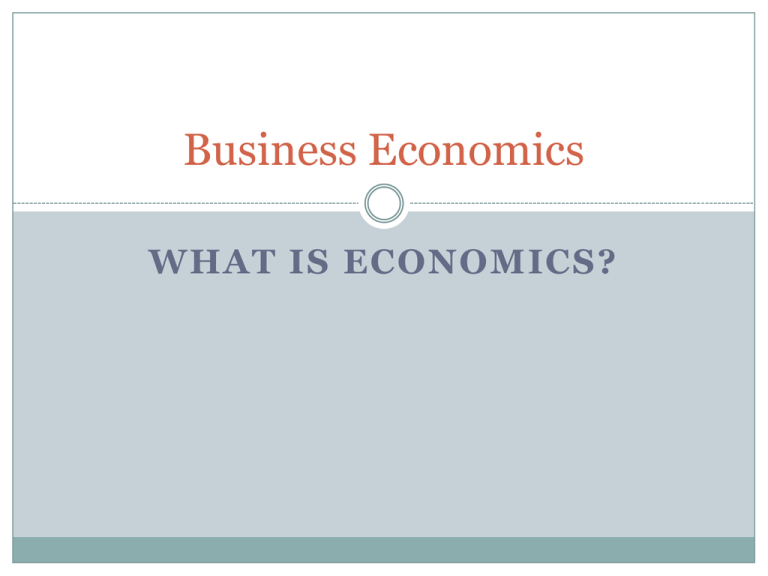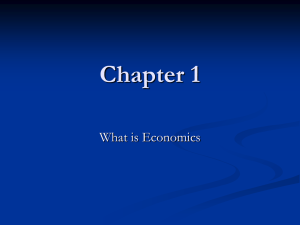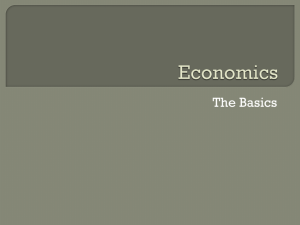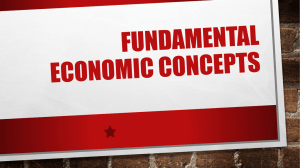What is Economics?
advertisement

Business Economics WHAT IS ECONOMICS? What is Economics? Economics - The study of how individuals, families, businesses, and societies use limited resources to fulfill their unlimited wants Microeconomics – deals with behavior and decision making by small units such as individuals and firms Macroeconomics – deals with the economy as a whole Why we study economics? We want to have good information as consumers to make sure we spend our limited resources in a good way. As a citizen we want to make sure the government is spending our money in a way with which we agree If we don’t agree with them then we can exercise our right as a citizen and vote for change Wants vs. Needs - Vocabulary NEEDS – Things we must have to survive. Examples: Food, shelter, and clothing WANTS – Things people do not need to survive, but can be used to enhance their lives Examples: car, computer, stereo, haircut Can one person’s wants be another person’s needs? Want or Need? Want or Need? Vocabulary continued… SCARCITY– Basic economic problem resulting from unlimited wants vs. limited resources Each decision made has an aspect of scarcity. People do not & cannot have enough income and/or time to satisfy their every want. Examples: gasoline, time, etc. SHORTAGE– Temporary restriction of resources due to an unforeseen event Example: property hurricanes or floods destroy goods and Goods vs. Services GOODS SERVICES Tangible items that Activities that are done people can buy & sell Clothing, Food, Tables, Cars, DVDs for you by someone else Hair cut, medical examination, car wash, seeing a movie at a movie theater Goods or Service? Business Lumber Goods Service Both X Carpet center Bus Line X X Book store X Department store X Chipotle X Dry cleaners X Factors of Production FACTORS of PRODUCTION – resources needed to produce goods and services 1. Land (natural resources) Natural resources that exist without human interference Examples: surface land, fish, animals, trees, minerals, water 2. Labor (human resources) Work people do to produce goods & services Factors of Production continued… 3. Capital Previously manufactured goods used to make other goods or services Examples: machines, buildings, tools Increases Productivity PRODUCTIVITY – Amount of output that results from a given level of inputs (land, labor, capital, and entrepreneurship) 4. Entrepreneurship Development of new businesses, products, or services Always has an element of risk!! Factors of Productions 5. Technology Utilizing new methods for producing goods and services more efficiently Examples: Computers v. Typewriters; Smart phones v. land lines What type of resources are these? What type of resources are these? What type of resources are these? What type of resources are these? What type of resources are these? QUICK QUIZ!! Identify these items as wants or needs? Are the following items scarce or is there a shortage? QUICK QUIZ!! What is the basic problem of economics? What is Economics primarily concerned with? Main Idea: Economic decisions always involve trade-offs… TRADE-OFF – Sacrificing one good or service to purchase or produce another Most of our “trade-offs” involve sacrificing our time or money Example: if you choose to buy an iPad, you are exchanging your income for the right to own the iPad. You might also sacrifice other things Can you think of scenarios where you might sacrifice something other than time or money? What are some recent trade-offs you have made? …and those trade-offs have costs OPPORTUNITY COST – The value of the single next best alternative given up for the alternative that was chosen Think of it as the runner-up item!! Production Possibilities Curve Shows the maximum combinations of goods/services that can be produced in a certain amount of time with a given amount of resources. Can be used in all aspects of our economy Personal Life Business Government Economic Models ECONOMY – The production & distribution of goods/services in a society ECONOMIC MODEL – A theory or simplified representation that helps explain & predict economic behavior in the real world A VISUAL REPRESENTATION of consumer, business, or other economic behavior Relate to the way individuals (as consumers) and business people react to changes in the word around them Economic Models Steps to creating an economic model: Gather Information/Facts Develop a theory/hypothesis HYPOTHESIS – An assumption involving two or more variables that must be tested for validity Create an Economic Model Test the Model Discard the facts that are not relevant Requires additional research above the initial information gathered. Revise Model If research shows the original economic model was incorrect a new model would need to be made. WHICH GRAPH SUPPORTS THE THEORY LISTED BELOW? An Economic Theory: Teenage Unemployment increases when the Minimum Wage increases Group Activity Concluded Economic Decisions Return to your group and discuss the following: Graph the information below; then discuss and decide if you would like to increase production or not. ASSUME that the average hourly wage for teenagers is expected to increase soon. Explain your decision Teenager’s Average Hourly Rate Percent of Income used for Purchases $3 5% $6 18% $9 30% $12 38% $15 49% Schools of Economic Thought Economist deal with FACTS Their personal opinions & beliefs may influence how they view those facts and fit them into theories Government may influence a person’s interpretation as well The Bottom Line ECONOMICS IS NOT BLACK & WHITE! The Science of Economics is not used to judge whether a certain policy is good or bad. It is used to inform us as to the likely outcome of the policies.






